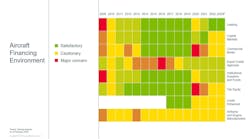Every year 4,800 Part 145 repair stations are inspected at least once by the local Flight Standards District Office (FSDO). Some repair stations are inspected more often by the local FSDO because of their size, complexity or perhaps a shaky level of past performance.
I would like now to offer you a system to lower your anxiety level about FAA inspections. The system is a self-audit test that should take you a couple hours to complete. The test is composed of questions that are similar to the ones asked every day by the FAA inspectors performing repair station inspections worldwide.
Our self-audit is broken down into six areas of concern: the management team, certificate and ratings, your inspection manual, personnel, record keeping and your facility.
By the way, if you want this self-audit to work, you have to treat it like the real thing.
FAA Repair Station – Self-Audit
Questions for your management team:
- Who has overall responsibility for the repair station?
- Does that person know his or her duties and responsibilities?
- Is that person qualified? Can you prove it?
- Does that person know he or she is qualified? Was anything signed accepting that responsibility?
- Can that person tell me how the repair station inspection is run?
Of the first five questions, No. 5 is the most important. If the manager can’t describe the repair station inspection system, or worse yet, the system described is different than what the manual calls out, then I have some serious doubts to the accuracy of the answers to questions No. 1 through No. 4. This is not a auspicious beginning.
Questions on your certificate and ratings:
- What ratings do you have? Are you doing work other than what you are rated for?
- Where are your FAA repair station certificate and operation specifications documentation displayed?
- Do you still have all the equipment that you had when you were certified? Is it serviceable?
- Who is responsible for work that’s subcontracted out? Are subcontractors identified? Where? Are they repair stations?
It’s a mistake to think that a Part 145 certificate hanging in the lobby with a list of ratings is for display only. It also lists the repair station’s privileges and limitations. The certificate is very similar to the certificate that an A&P holds.
To abuse the ratings and sign off more than what the repair station was inspected and certified for is a breach of contract between the repair station and FAA. It would be the same as an A&P signing off an annual inspection. The federal government doesn’t take a warm and fuzzy attitude toward either kind of performance from the folks they certify.
Questions about your inspection procedures manual:
- Who has copies of the inspection procedures manual?
- Is it accessible to inspection and maintenance personnel?
- Who is responsible for revisions to the manual? How is this accomplished?
- Are the latest revisions inserted in all the manuals, including the ones sent to the FAA?
- Does the inspection procedures manual accurately reflect how the repair station operates? This includes referencing the latest specifications or procedures presently being used on the floor.
Correct answers to these five questions are vital because the inspection procedures manual is your repair station’s bible. It’s your show-and-tell book that’s supposed to describe who you are, what you do and how you do it. It should be written in such a way that anyone, after reading the manual, should have a clear understanding of how you operate.
If you can’t answer the five inspection procedures manual questions with a high degree of confidence, doubts are raised. At this point I’d have to question you on how you’re complying with FAA regulations when you have no controls or safeguards built into your organization to ensure safety.
To be honest, I would subjectively appraise your repair station as one that’s less than professionally run because I’ve found that your daily operational inspection and repair procedures are being done off-the-cuff.
Personnel questions:
- How many repair station personnel do you have? Do you have a list of who they are and what they can do?
- Do you have enough people for the amount of work performed?
- Are they trained both initially and on a recurrent basis?
- How do you record the kind and amount of employee training? Please show me a sample of an employee training record?
- (Picking an employee at random) How does the repair station inspection system work?
- How many FAA certified personnel do you have? Who is authorized to sign off work?
Do you have significantly less employees now than when you were certified and do you still perform the same amount of work? If so, why? Are your remaining employees burdened with many job functions to make up for missing personnel? To find the answers I would first check your overtime records. Has there been a constant, long-term requirement to pay overtime? If so, then this is a good indication that you don’t have enough people to do the work.
Next, I would look at your warranty or rework records and if your rework is above 5 percent, it’s a good indicator that your people are improperly trained, fatigued or both. These two causes are perhaps the main reasons why you have a large percentage of work to do over.
Question No. 5 is the same question I asked management earlier. If I receive the wrong answer or just a shrug from the employee on the floor, this would really start alarm bells ringing. If the person doing the work on the floor has no idea what and how the system is supposed to work, who does?
Questions about your record keeping:
- Are the records used on the floor the same as those in the inspection procedures manual?
- May I see a record of maintenance that you performed two years ago?
- Please show me a copy of your maintenance release for a major repair or major alteration.
- Who is approved to sign the maintenance release? Where is that information found?
- How is acceptable data and approved data identified on your maintenance records?
- Is “total time” reflected on all inspection records? (ref. 43.11)
- How are Part 121 and Part 135 maintenance records processed? Where are these procedures found? How are required inspection items handled?
- How are maintenance records for work performed by subcontractors handled? Where are these procedures found?
- How are malfunction and defect reports submitted?
Shoddy record keeping is the “silent scream” that will alert me to major organizational problems within your repair station. It tells me that there’s little or no communication between your quality control, maintenance department and parts department.
No communication means no coordination between departments. This forewarns me that no focal point for record responsibility exists in your organization, which in turn is one of the major causes for incomplete or poor record keeping.
Questions about your facility:
- Is your current facility identified in your manual?
- Is all your required equipment serviceable?
- Is there proper lighting and heat in the shop area?
- Are the maintenance library, AD and Service Bulletins current?
- Who is responsible for keeping the library current?
- Are your subcontractors’ libraries current? Can you prove it?
- Are all tools and special equipment properly calibrated?
- What procedures are used in the event that a calibrated tool is abused?
- If so, where can I find this information?
- Who is responsible for the facility condition?
- Is the facility large enough to do the work performed?
- Are conflicting work functions (i.e.: painting; buildup) segregated?
- How are life limited parts handled?
- How do you separate serviceable from unserviceable components?
- Who is responsible for ensuring that all consumables (gaskets, seals, hoses, etc.) have not passed the cure or drop dead date?
Your facility is your home away from home. If it’s dirty, cramped and more like a dungeon than a place to work, my first impression is that the work performed here will be less than satisfactory, and safety is compromised.
If you really spent some time with this self-audit, the FAA shouldn’t appear so frightening to you. For you’ve audited the repair station yourself. You know what needs to be fixed and what can be left alone.
The self-audit test should be done once a week by all department heads. This self-audit should be improved upon and personalized by adding specific areas of concern relative to your own repair station until it becomes part of your repair station management culture.
This article first appeared in the July/August 1992 issue of Aircraft Technician.

